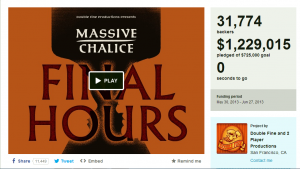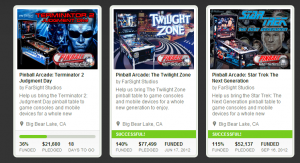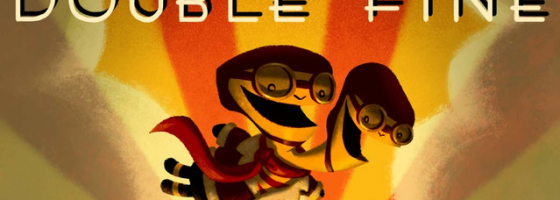As we know, crowd-funding exploded last year thanks to kickstarter and games like Project Eternity, Shadowrun Returns and the Double Fine adventure game: Broken Age. Crowd-funding has become a new source of income for game developers big and small.
But as with other good ideas, it can be open to being exploited and has me wondering where the line is on Kickstarter.
Where The Funding Goes:
The original purpose and general intent of crowd-funding sites like Kickstarter and indiegogo are to let people pitch a variety of projects and hopefully receive pledges from people interested in them.
The money that is donated will of course go to the owner of the project to be used in the development. It sounds so simple, but over the last year we have seen some projects that in my opinion betray the trust of the donators.
The telltale sign is the actual goal of the funding, or what the money that is donated will be used for. There was a project last year that did crowd- funding from their own site where the money pledged would not go towards the game development, but for convincing investors to give the owner the actual funding (if anyone remembers the name, please post it in the comments.)
Since kickstarter has entered the limelight there has been an argument specifically among game projects as to the purpose of pledging money. Because of the scope of a game project, some feel that donating to a kickstarter is akin to pre-ordering a game. So when we see kickstarters aimed at not making a game, but a prototype or simply to convince an investor to fund a game, it can feel disingenuous.

Massive Chalice just finished on kickstarter in time for DoubleFine’s announcement of problems with Broken Age
Another issue comes down to who is putting up the campaign.
There is a huge difference between a small indie group and one person developer looking for funding vs. someone who is known to already have deep pockets.
While the general intent of a kickstarter is open to debate, there is another major aspect that we haven’t talked much about: what happens after the kickstarter?
The Funding Fall-out:
After a project has received funding all that’s left for the donators is to wait for the project to be released. The general kickstarter strategy for funding is to set your goal as realistically small as possible. IE: The less you need to ask from people, the easier it is to achieve.
What that means is that for the projects that make it by the skin of their teeth, the funding will effectively cover that one project and that’s it. Leaving the project owner in a situation where after everything is said and done, they may not have enough money to continue working.
That raises a question that hasn’t been asked yet: Is it alright for someone (or a company) to keep using kickstarter for funding?
With Doublefine, they have had two kickstarters in less than a year, one for Broken Age and the second one for the strategy title Massive Chalice.
Now, like most people I donated to Broken Age as I assumed that this was an all-or-nothing situation: that if they didn’t receive the funding that the studio would not be able to make any more games.
As we know, the kickstarter earned about eight times more what they were asking for. And then in May, they announced a second kickstarter with a higher goal. Now I understand that Double Fine is a big studio and they can work on multiple projects at once, but I can’t help but feel a little bit cheated after so much commotion was made over the original kickstarter.
Honestly, if I would have known that Double Fine was going to do this, I would not have donated to the adventure game and instead would have pledged towards Massive Chalice as that idea sounded more interesting to me.
And even with the success of both kickstarters, Double Fine recently announced that they are running out of money to finish Broken Age and will have to release it earlier to hopefully earn enough to complete the entire game.

Farsight has been using kickstarter to help secure the funding to acquire the licenses for popular pinball tables.
Now Double Fine is not alone in double-dipping on Kickstarter, American Megee from Spicy Horse Games had a kickstarter at the start of the year for the game Akaneiro: Demon Hunters.
The game was put on Steam in early June and is still considered in “launch state” and Megee launched another kickstarter for the game Ozombie. Like Doublefine, he is asking for several times more money than the first project.
There was also InXile Entertainment that successfully kickstarted Wasteland 2 and Torment: Tides of Numenara. From reports of people who have pledged, both games are coming along fine.
As an example of what I considered a positive of using kickstarter multiple times is FarSight Studios, the developers behind the Pinball Arcade. They have used kickstarter three times successfully and are currently working on a fourth project.
The kickstarter money is used to acquire the pinball licenses to digitize some of the most recognizable tables. Their second kickstarter for Star Trek TNG earned them more money than what was needed and they used that towards the goal for their last kickstarter: the Terminator 2 pinball game.
Now, is Farsight’s use of kickstarter considered better than Doublefine or Spicy Horse? Honestly, I don’t have the authority to make that call. It will be ultimately decided on by the fans and who they give their money to.
Lastly there is the issue of projects that fail. There have been cases over the last year where a kickstarter project that succeeded, still failed to release their game. This could be for any number of reasons: money ran out, design didn’t work, team fell apart etc.
Recently the kickstarted board game : The Doom That Came to Atlantic City received more money than what was needed and still failed to come out. At this current time, people are looking into legal action against the creator and it is anyone’s guess if pledgers and pre-orders will get refunds.
Nothing will sour someone faster on crowd-funding more than having a project that they heavily backed, fail to be released. And if enough people get burned on crowd-funding and never do it again, the entire concept could die for any major project.
The full ramifications of Kickstarter and crowd-funding have yet to be seen. At this point in time, only Shadowrun Returns has been released in terms of major game project successes. I feel that when the time comes that all the big projects have been released, that will be a pivotal moment for crowd-funding for the Game Industry.
I’ve been looking at kickstarter myself for a few projects of mine and you can bet that I’m going to continue keeping a close eye on kickstarter for the coming months.


